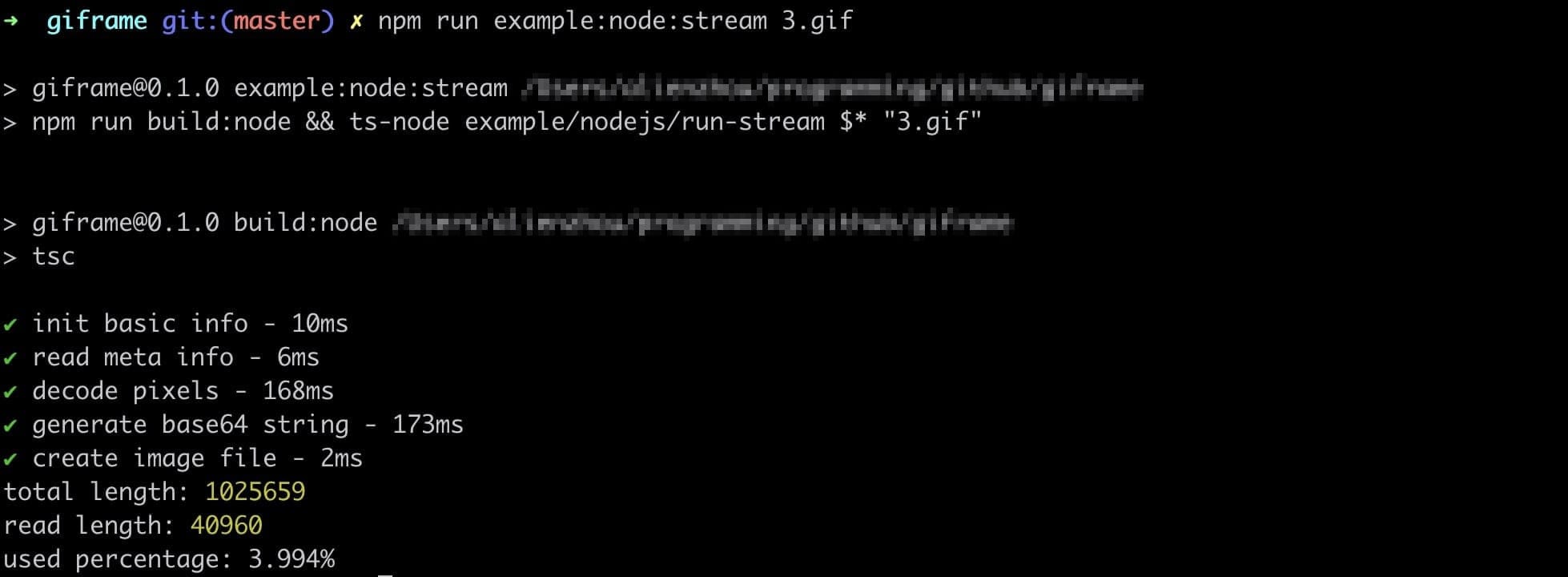GIFrame 📸
GIFrame.js can extract the GIF's first frame without reading whole bytes in both browsers and NodeJS environments.
It's fast (decode on-demand) and compatible (both in browsers and nodejs).
No need to wait for and read all bytes and decode chunk by chunk, especially when only extracting the first frame. So it may be used for improving GIFs loading experiences, providing more controllable GIF loading strategies and so on.

Motivation
Some websites contain a lot of GIF images. Displaying animation images in your homepage, item list and so on may attract users' attention. However, GIF images are much larger than static images (sometimes 20x~30x depends on how many frames).

As a result, users need to wait for a long time to see GIF images. A common method is to extract the first frame as a placeholder and load GIF lazily when in view or clicked. There are lots of libraries to extract frames in the server-side. However, it has some limitations:
- Most libs need to read whole bytes in GIF for extracting frames, even though we only need the first one. It's a waste of computing and time. For example, the first frame only use about 16% bytes in
example/img/4.gif(8-frames) and . - This solution needs the support of the server-side or CDN. Is there any frontend-only solution to improve user experience?
This repository aims to provide a stream-like (decode chunk by chunk) GIF decoder which can run in both browsers (client-side) and NodeJS (server-side).
- It will try to extract the needed frame without reading all bytes. You can read bytes and decode at the same time. It is useful especially when using stream in I/O.
- Running in browsers means you can display a early static frame when downloading GIF, or use the client itself to calculate.
Below is an browser example. The first frame is extracted and used as a placeholder while the GIF image is still loading.

You can also play with it by yourself. Go to the Example section >>
Basic Usage
Support both in browsers and NodeJS,
import GIFrame from 'giframe';const giframe = new GIFrame();giframe.getBase64().then(base64 => { // finally get the base64 string of the first frame console.log(base64);}); // then read GIF bytes from network, local file and so onconst source = readGIF('xxx.gif');// chunk need to be Uint8Arraysource.on('data', chunk => giframe.feed(chunk));More complex usages can be found in example/ directory. You can also run examples below ↓↓↓
Example
Nodejs required.
This repo provides some examples in example/ which give you a quick start.
Firstly, clone the repo and install dependencies.
git clone git@github.com:alienzhou/giframe.gitcd giframe # install dependencies npm iRun in browsers,
npm run example:browserThen it will open http://127.0.0.1:8080 (default port 8080), you will see a demo page ↓

Or run in NodeJS,
# extract the first frame image # you can change the gif filename (1.gif ~ 5.gif) npm run example:node:stream 1.gif # or you can run npm run example:node:limit 1.gif # then the first frame image will be written in example/output 
How it works
For a quick and robust start, the decoder is mostly a folk of omggif. GIF is composed of many blocks. Giframe treats every block as a valid unit and resets the position to the previous block's end when meet an incomplete block. It will try to continue to decoding when receiving another chunk (more bytes). It's like stream.
To generate the image's base64, Giframe uses the Canvas API - node-canvas in NodeJS and native canvas in browsers. The canvas uses all RGBA pixels which are provided by Giframe to render a image and exports base64 string by .toDataURL().
By the way, the example in example/browser uses Service Worker, fetch event, fetch API and Readable Stream. It tees a stream from the response in fetch API and read it. Every chunk received will be used to decode progressively. Once the first frame is ready, it will be displayed on screen as a static preview.
Compatibility
Discarded:
Now GIFrame.js usesProxyobject to throw an error when accessing an out-of-range item inUin8Arrayand catch it in the decoder to reset to the previous valid block's tail position.Proxyobject isn't compatible in some browsers.
After v0.2.0, GIFrame uses a basic get function instead of the Proxy object. So mostly its compatibility depends on Uint8Array and Int32Array which are supported in most browsers.



